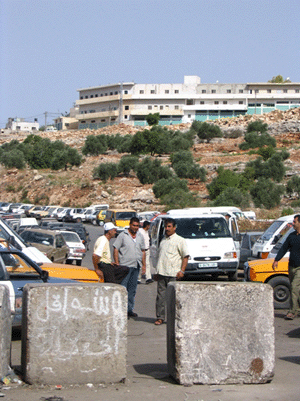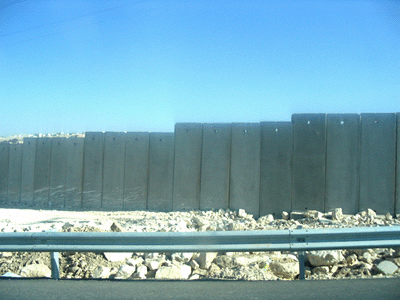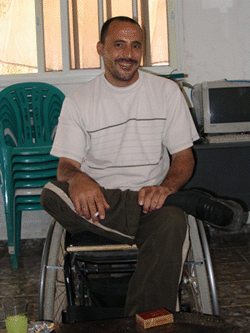In June, 2005, while traveling in Palestine, I had to pass through several checkpoints in the West Bank. I was a tourist, and the intimidation of guns, barbed wire, and snipers from the watchtowers made me sweat. I felt like I had done something wrong even though I hadn’t, and was utterly humiliated by the experience. Although I had every right to be where I was, I was treated as an intruder and a potential criminal, with my basic rights to free movement and expression called into question. I came through the other side cursing the checkpoint and those who staffed it, anger welling up inside me. Many Palestinians live their entire lives with these feelings, and thousands have to commute from a home on one side of a checkpoint to work on the other side every single day.
The futility of the soldier poking their hands into women’s grocery bags, babies dangling from their hips, is bizarre. It is also extremely time consuming. While standing impatiently in the hot sun at the Nablus checkpoint I though about how much time Palestinians lose by standing at these checkpoints. They lose time that could be spent with their families, time at work, time for cultural and spiritual events. The checkpoints steal the ability of the Palestinians to maximize their productivity, and enforce the idea that Palestinians aren’t in control of their lives.
There are 118 roadblocks scattered all over the West Bank, giant cement blocks set down in a row across previously continuous paved roads. Earth mounds and earth walls number a staggering 317, mostly blocking the highways and smaller roads and also scattered everywhere. What these mean in reality is that one cannot travel for more than forty miles or so without having to get out of the bus or servis (shared taxi), walk over to the other side of the roadblock, and wait for the public transportation to fill up again. Between Jerusalem and the village of Haris I had to do this twice, and each time it took about 30 minutes for my servis to fill up. The sun is beating down and people are just standing idly, waiting for more people to come. It is a very inefficient use of time, and again, decreases Palestinian productivity.

[Photo: Roadblock in the northwest Salfit region of the West Bank, near Ariel settlement block]
In some instances, communities have gotten together to remove the roadblocks and have succeeded in pushing the concrete or rubble out of the road. However, the Israeli soldiers come by routinely to check on their creations, and generally punish the rebellious villages with tear gas, sound bombs, and bigger roadblocks. Transportation networks look like public facilities in the deep south of the USA prior to the civil rights movements, one side for Palestinians, another for Israelis. There are entire road systems through the West Bank that only Israelis are allowed to travel on. Palestinians usually travel in cars registered with the Palestinian Authority, which have green and white license plates, while cars registered with Israel have yellow and black license plates. Only cars with yellow license plates are allowed to travel on the Israeli-only roads, which generally connect the settlements, but also pass through or near major Palestinian cities.
Separate and Unequal
The separation wall was originally supposed to be built along the Green Line, established in the armistice agreement between Israel and Palestine in 1949, when Israel viewed the line as their border. Since the 1967 war, however, Israel has occupied all of the West Bank, thus soldiers work both sides of the Green Line and it serves mainly to control the movement of Palestinians.
One of the major points of controversy is that the actual wall, in some places made of concrete slabs and in others of metal mesh topped with barbed wire, is not actually being built on the Green Line. Rather, the wall is being constructed in some places several kilometers further into the West Bank, which Palestinians view as a blatant land grab attempt. " IDF security experts argue that the topography does not permit putting the barrier along the green line in many places, because there would be hills or tall buildings on the Palestinian side" (Mid East Web). It would not be considered a viable strategy for the wall to be pulled back onto the Israeli side.
The United Nations Office for the Coordination of Humanitarian Affairs provides excellent up-to-date maps of both the West Bank and Gaza, showing the parts of the separation wall completed, under construction, and projected, as well as the numbers of road blocks, checkpoints, and other types of barriers put in place by Israel. According to the April, 2005 map, there are 605 types of obstructions to Palestinian movement in the West Bank alone.
This level of occupation has led to increased anger and despair among the Palestinians, as well as an increase in dysfunction among the Palestinian Authority, who were ceded a limited amount of control over some Palestinian cities in the Oslo accords of 1993. Without the ability to generate finds through an export economy, much of the Palestinian government is stagnating, unable to provide the improvements to schools, roads, health clinics, and refugee camps that its people are demanding.

[Photo: The separation wall between Ramallah and Bethlehem]
While some Palestinian communities have accepted the wall being built next to their villages, many have not watched in silence. With a tremendous passion and basic organization skills, villages have staged protests all along sites of wall construction. Usually, these clashes take place when the construction is first beginning, and the retaliation of the IDF has been swift and brutal.
In the village of Marda in the Salfit region, soldiers shot several rounds of rubber bullets at point blank range, and lobbed tear gas and sound bombs into the crowds, which are multigenerational affairs. Grandmothers are there with their families, coughing though the toxic gas to voice their resistance. Of course, what the Israeli press always reports are the 14 year old boys who throw rocks at the soldiers, thus justifying the use of militia to subdue this threat to their physical safety. Indeed, in the village of Hares, where the International Women’s Peace Center (IWPS) has its base, I saw a group of boys practicing with their homemade slingshots. The sight of their rubber band and rag weapons made me want to weep. Like rebellious adolescents around the world, these boys will express their anger when they feel squeezed by authority. Unique to Palestine, however, is the fact that several will become martyrs before they can grow mustaches.
One of the tactics that has developed in the community protests, which are sometimes assisted in their structure by international organizations and volunteers like folks from IWPS, is that the women are in the front lines of the demonstrations, to curb the male aggression that has led to extreme violence when the Palestinian men are face to face with the soldiers. This tactic has worked to some extent, but each year in the West Bank, men, women, and children are killed by the IDF, often at the site of wall construction.
I met Issa Suf in his home in Hares village which stands opposite the enormous Israeli settlement city of Ariel in the West Bank. On May 15th, 2001, the anniversary of the creation of the state of Israel in 1948, which Palestinians refer to as al Naqba, or ‘the catastrophe,’ Issa and fellow villagers were peacefully demonstrating against the Israeli occupation. Israeli soldiers stormed the village to break up the gathering, lobbing tear gas canisters and shooting live ammunition. Parents tried to herd their screaming children into houses, and Issa was shot in the spine. He is now paralyzed from the waist down and will be in a wheelchair for the rest of his life. "Even though," Issa proclaims, in a letter to the soldier who shot him, "I have reason to hate you, I don’t feel that way." Of the Jewish people, he says, "I don’t understand how yesterday’s victim can become today’s criminal. That worries me in connection with today’s victim – my people I am afraid that they too will become tomorrow’s criminals" (Ha’aretz, 7-9-04). Today Issa continues to advocate non-violent protest and focuses on community-building projects.

[Photo: Issa Suf, paralyzed from Israeli bullet in 2001]
Often, the element of surprise regarding the wall location adds to Palestinian frustration. I went with an IWPS volunteer, Hannah, to the Mayor’s office in Biddya, a town located many kilometers from the Green Line but in a region of dense Israeli settlements. Hannah had acquired the most recent UN maps of the separation wall, which was not supposed to come near Biddya, as far as the Mayor knew. When Hannah placed the maps on his desk, he drew a sharp breath and his forehead knit together. He shuffled papers and pulled out the last map he had been given, which showed the wall a reasonable distance away from his community. Nobody had talked to him about changing the location of the wall, and yet here it was, now bordering his village on three sides. If IWPS wasn’t doing its work, he might not have known until the IDF bulldozers revved up to move aside olive groves and chicken sheds that blocked their construction site. How can democracy operate in the absence of transparency?
The reality of separation is not just keeping suicide bombers out of Israel, it is, according to a professor of art in Dheisheh Refugee Camp, "keeping families in different villages from visiting each other, and it keeps the farmer from his field."
Mneesha Gellman is Associate Producer of "A World of Possibilities" radio program at the Mainstream Media Project in northern California. She traveled to Israel and Palestine in June 2005. This is the third of four articles she will write for Toward Freedom.
Works Cited
Ha’aretz. Newspaper article. July 9th, 2004. Gideon Levy Interview with Issa Suf.
Suf, Issa. Personal interview with Mneesha Gellman. June 13th, 2005. Hares, Palestine.
Interview with Radio 194 host and refugee, from CD recording by Radio 194, Dheisheh Refugee Camp, Palestine. 2004.
